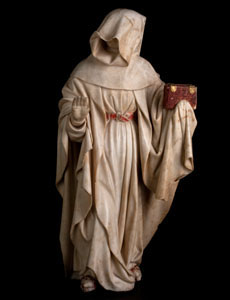Last month we mourned the passing of quietude in restaurants and bars. Hushed conversations and clinking of glass are now overwhelmed by broadcasts from amplified TVs and loudspeakers in all but a handful of clubs.

Hauntingly spare, yet crafted with astonishing detail, the alabaster sculptures of “The Mourners: Tomb Sculptures from the Court of Burgundy,” currently at the Legion of Honor, is an impressive exhibition featuring 37 exceptional devotional figures that recreate the mourners in a royal funeral procession.
By Paul Duclos
Published: September, 2011
Last month we mourned the passing of quietude in restaurants and bars. Hushed conversations and clinking of glass are now overwhelmed by broadcasts from amplified TVs and loudspeakers in all but a handful of clubs. At the same time, we champion live performance, which keeps professional musicians at work and brings sophisticated entertainment to our dining and drinking experiences.
Thanks to new legislation introduced by Supervisor Ross Mirkarimi, it has become easier for cafes and scores of smaller restaurants and saloons to obtain a live music permit at a fraction of the original cost. We applaud this move, and thank co-supes David Campos, Scott Wiener and Eric Mar for their support of this truly progressive legislation.
Which brings us to recommend a favorite music-making boîte in Jackson Square. Often referred to as 150 Montgomery, the Cigar Bar & Grill is frequented by the City’s savvy legal and financial crowd, who come for cigars, a friendly game of pool, casual cuisine, and the high-energy music of Fito Reinoso and Ritmo y Armonia. Besides playing Cuban New Wave, the orchestra performs more traditional Cuban genres such as son-montuno, cha-cha-cha, and bolero.
In a declining era of genuine adult hideaways, this place is remarkable. With its low lighting and comfortable club chairs, one almost recalls the exciting seventies joints Henry Africa and Lord Jim’s.
After burning the candle at both ends, we suggest you take in The Mourners: Tomb Sculptures from the Court of Burgundy, currently at the Legion of Honor.
This small but impressive exhibition features 37 exceptional devotional figures that recreate the mourners in a royal funeral procession. On loan from the Musée des Beaux-Arts de Dijon, these delicate carved figures have never before been seen in their entirety outside of France prior to the current seven-city exhibition tour.
The figures were commissioned for the elaborate tomb of the second Duke of Burgundy, and carved by Jean de la Huerta and Antoine le Moiturier between 1443 and 1457. Hauntingly spare, yet crafted with astonishing detail, the alabaster sculptures exemplify the most important artistic innovations of the late Middle Ages.
A great deal of the success of this project goes to the French Regional & American Museum Exchange (FRAME) in the United States. As Richard R. Brettell, founding director of the exhibition, explained, the project allows the sculptures to be viewed and appreciated as discrete works of art.
The sculptures, each approximately 16 inches high, depict sorrowful figures expressing their grief or devotion to John the Fearless (1371–1419), the second Duke of Burgundy, who was both a powerful political figure and patron of the arts. The tomb, which is not traveling with the exhibition, contains life-sized effigies of the duke and his wife, Margaret of Bavaria, resting upon a slab of black marble. The procession of mourners weaves through an ornate Gothic arcade beneath.
Each individual figure has a different expression—some wring their hands or dry their tears, hide their faces in the folds of their robes or appear lost in reverent contemplation. The motif echoes that of ancient sarcophagi, but these innovative tombs were the first to represent mourners as thoroughly dimensional, rather than in semi-relief. The presentation of the mourners passing through the arcades of a cloister was also a great innovation for the tombs of the era.
In addition, a special website dedicated to the mourners (www.themourners.org) provides extensive historical context, as well as 360-degree views of each sculpture in two and three dimensions, allowing visitors to intimately examine every detail from every angle. The website, offered by FRAME, also features an interactive exploration re-creating the tomb’s cloister arcade and showing the mourners in situ.
For more of my unique insights and updates, visit paulduclosonsanfranciscoculture.blogspot.com.

